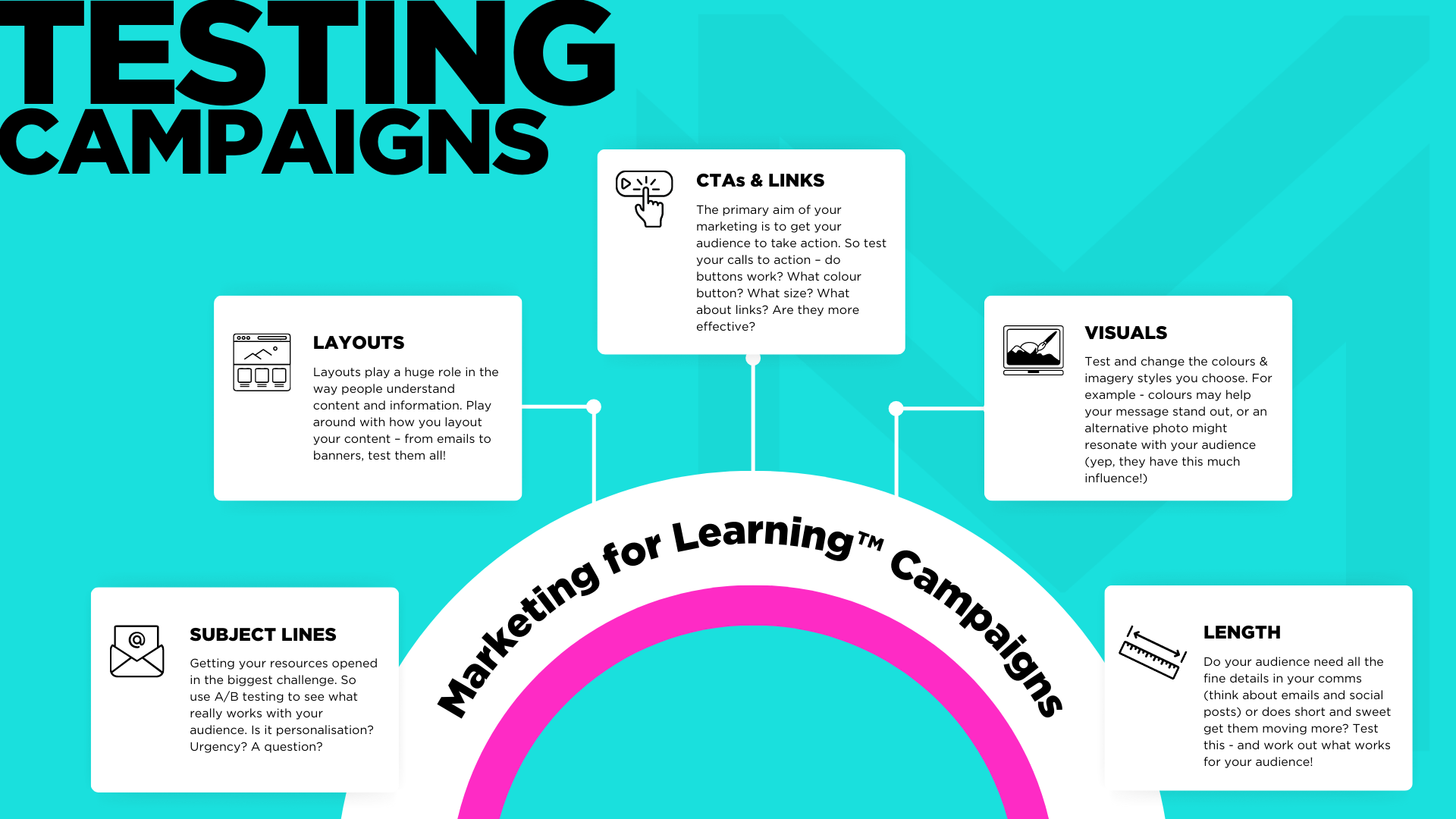want some cookies?
We use cookies to make your browsing experience amazing.

Picture this: you’ve spent weeks, perhaps even months, developing a marketing campaign for your new learning initiative. You’ve carefully crafted every step of your campaign, selected marketing channels and tools that you think will best suit your target audience. Quite simply, you’ve created a campaign that you’re really proud of. You click launch. You do a happy dance around the office because your campaign is underway. And then you do… nothing.
Yep. Absolutely nothing.
The campaign’s done now, what else is there to do?
You get to sit back and relax for the duration of the campaign, right?
Feet up on the desk without a care in the world.
WRONG.
Sorry to break it to you – your work has only just begun. Now is the time to put your assumptions to the test. Was that channel really the best choice? Did that email generate the click-throughs and actions you wanted it to? Did your influencer marketing boost engagement? These are all questions that can be answered by testing your marketing for learning campaigns.
Testing your Marketing for Learning campaigns is vital
If you’ve ever looked at a blueprint for a marketing campaign, testing is always the final step. But you know what they say – you save the best for last. Testing is the only way you’ll know if all your hard work was worth it. It's the only way you’ll prove (or disprove) your assumptions and it's the only way you’ll get long-term marketing results.
Marketing for Learning isn’t a process of just putting out some comms and hoping for the best. Instead, we need to learn what works for our organisations, we need to understand what our target audience needs from us, and we need to evaluate everything we do so that we can do it better next time.
Sometimes, marketers can put together a piece of work that in their opinion is the bee’s knees. The best. The cream of the crop. But when that ‘launch campaign’ button is finally pressed – the target audience glosses over it, barely paying it any attention. They don’t click our Call To Action (CTA) buttons. They don’t sign up for our new training programmes. They don’t do a thing. And the harsh truth is – no matter how much you love a campaign if it doesn’t work for your target audience, it isn't a good campaign.
Just because it worked for someone else, doesn’t mean it’s going to work for you
When I speak about testing, I often have people say things like “oh, but it worked for X brand, so I’m sure it’ll work for us too!” And trust me when I say that's the most dangerous excuse to get out of testing your marketing efforts. Here's why:
There are two restaurants in London. Less than two miles apart. Both sell food. Both sell pies. But the same marketing tactics wouldn’t work for both of them…
…because one is Heston Blumenthal’s restaurant ‘Dinner’, where a Fable Mushroom Pie would set you back 50 quid. The other is a Greene King Pub, where you can get a Steak and Ale pie for just £13.99. Their target audience is completely different.
And that’s why testing is so important – particularly in L&D. You may have heard of another organisation creating amazing marketing for learning campaigns that really worked for them – and assume it’ll work for you. So you copy it - all the way down to the finest detail – and expect the exact same results. But it doesn’t happen. You don’t get the phenomenal results you expect – why? Because you have an entirely different, and unique target audience – no matter how similar you might think their needs are. The truth is, the only way to know what will work for your audience is by testing your marketing for learning campaigns.
5 areas you should always test in your marketing for learning campaigns
So now we know why testing is so important – let’s get practical and look at what you should be testing, and how you can test these elements going forward.

1. Subject Lines & Headings
First impressions count. The subject line to your emails, or the heading on your ads, leaflets, and videos is the first thing your audience will see. It is because of your subject line that your audience will open your email. Your headings will get your people to read on. So these should be given the care and attention they deserve. Use testing to determine what resonates with your audience. Is it personalisation? Urgency? A question? Or something completely different? Identify a few styles that work for your audience – and bear them in mind in all of your future marketing activities.
TIP 1: A/B test your email subject lines. A/B testing is pretty simple; you provide 50% of your audience with one subject line and 50% of your audience with another. Absolutely no other changes should be made to your email. The images, colours and content should all be identical – the only thing that will be different is the subject line. Then, once the email has been sent you can see the difference (if any) between the open rate will indicate which subject line better resonated with your audience.
If you don’t have access to an email marketing platform that gives you open or click-through rates, have no fear! You can still A/B test your subject lines. Split your audience into two groups - send one group email A, the other email B. You can then measure how many people in each group take the action you desire – this will tell you which email worked best!
2. Layouts
The way your content is laid out can make or break your marketing. They play a huge role in the way people understand content and information. Play around with how you layout your content – from emails to banners, test them all! Do two columns work better than one? Or vice versa? Remember NOBODY can give you the answer to this for *your* people – you must test to work out what works for your unique audience.
Want some inspiration for how you can break the norm on your layouts? Check out these websites: Really Good Emails, Marketing Examples, and Dribbble.
TIP 2: Don’t be afraid to break the status quo. Trying something new, testing it and evaluating its impact is a MUST if you want to get the most from your marketing efforts. But for your testing to be accurate, you need to adopt A/B testing like we mentioned above. For example, using the same content and information in a different layout.
3. CTAs and Links
When creating digital marketing materials, people often opt for a CTA (call to action) button. Of course, there’s a huge benefit in using a button, the unspoken universal digital language means the majority of your target audience will know they’re meant to click the button. But that doesn’t mean your button should look the same as everything else online – nor should it look the same in ALL of your comms. Test your CTAs by trying different colours, sizes, text and so on. You could even test whether a button works at all – maybe including a hyperlink (blue & underlined) might increase your click-through rate? Only testing will tell!
TIP 3: Test, but bear user experience in mind. We’re huge advocates for breaking the status quo, but there are some things that are the status quo because they make users' lives easier. Take a hyperlink for example, most people will know that underlined text in a different font colour means it's a clickable link. Following this rule will ease your user experience and boost the efficacy of your marketing.
4. Visuals
When we’re trying to stay ‘on brand’, it can be really tempting to use the same images and colours over and over again. Because that’s on brand, right? But changing (and testing) your use of colours and imagery styles might help your message stand out. Or using an alternative photo might resonate with your audience better (yep, they have this much influence!) If you don’t have your own learning brand, choose an accent colour from your brand’s colour palette to create unity throughout your messaging.
TIP 4: Create your own learning brand! Although we’re challenging you to test and switch up your colours and images – we implore you to develop your own learning brand. Check out this article to learn more about learning brands.
5. Length
Does your audience need all the fine details in your emails or social posts? Or does short and sweet copy get them moving quicker? Test how the length of your copy influences the efficacy of your marketing. Some audiences might prefer to have all information up front, others might want you to cut to the chase. So test this, and see what your audience wants from you.
TIP 5: Often in L&D falls into a trap of trying to cram in every single fine detail about every single learning intervention into one piece of marketing. And this often confuses audiences – so make sure you're only including relevant info, no matter how long your prose is!
So the next time you let testing your marketing for learning campaigns fall on the back burner – think again. Test your campaigns, learn what works for your audience and boost the effectiveness of your future marketing endeavours.









